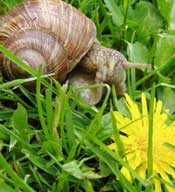 |
||||||||||
BIOLOGY |
||||||||||
|
BiologyThe Helicidae familyPulmonate land snails belong to the Helicidae family, and their best-known representatives are the species Helix pomatia, Helix aspersa, and Helix lucorum. Here, however, we refer to the biggest domestic snail, Helix pomatia, for centuries already having been very significant under the aspect of nutrition.
When stretched our Roman snail Helix pomatia has a length of approx. 8cm. The yellowish-brown chalk shell shows 5 brown bands and is almost ball-shaped. The shell of adult snails shows 5 coils and has a diameter of about 4cm. The shell has a reinforced edge. The body of a snail consists of three parts, foot, visceral sac with mantle cavity, and the head.
The foot is a very muscular part of the body with a flat bottom. On the rear it is tapered and on the front end it is turning into the head that includes the most important sensory organs and the excretory openings of the body. As the muscles of the foot are contracting and extending the wavelike, creeping movement of the animal is created. This goes along with the secretion of slime by numerous glands in the skin allowing the animal to glide. The foot can be pulled back into the shell by a strong muscle, extending from the pex of the shell along its axis and to the sole of the foot.
The surface of the visceral sac and the mantle fold are firmly connected to the collar of the shell and are producing the chalk for the surrounding, protective shell. The growth of the shell originates in this collar. Through a hole at the brink of the mantle cavity, the respiratory hole, the lun is taking in air from the outside. The sexual organs are built up in a very complicated way. Roman snails are hermaphrodites, and this means that each animal is furnished with male and female organs. Fertilisation is carried out mutually between two animals.
Under favourable weather conditions the animals' winter rest is ending in April already when they are creeping around between the fresh green plants. In end-May the mating season starts. The mating is preceded by a love play lasting for hours. As two snails are meeting they will mutually touch their tentacles and the mouth. Gradually they are getting into an upright position by bracing their soles against each other. Before the actual copulation the love dart is ejected from the copulatory hole; this is a needle-shaped structur and consists of calcium carbonate. It serves as an incentive for the partner. The peak of the dart will protrude into the skin at any point. The hit partner falls back, but after the pain has vanished it gets upright again and in turn ejects a love dart. After a period of rest the two animals will continue their love play until their mutual fertilisation.
The eggs are placed about 3 to 4 weeks later. With its foot the Roman snail will dig a roughly 5cm deep hole into loose-packed soil where it will place the eggs. A spawn of eggs consists of 20 to 60 pea-size eggs (5 to 6mm) with a whitish, glossy jelly shell. The young snails will appear after about three weeks. After having fed on the remnants of their egg-shell beneath the soil they appear on the surface and are feeding on delicate parts of plants. Their very thin shell is almost white and transparent, but soon will change to a ligh brown. A diversified nutrition might produce another spawn of eggs in the course of summer; however, this will contain only some 20 and odd eggs.
After 3 to 4 years only the Roman snail has grown to its ultimate size and then will be capable of reproduction. During the cold season the Roman snail holds a winter rest in the soil. To this purpose it will dig a hole, again by making use of its foot. The animal then will place itself with the opening of the shell showing upwards. The mantle collar then will produce a sluggish chalk pulp that will harden to a solid lid and closes the opening. As the snail is retracting further into the shell several thin skins will develop under this lid. In this state the Roman snail is capable of enduring relatively low temperatures.
|
SCHWÄBISCHE AUSTERPlease visit also the homepage of "Schwäbische Auster".
|
||||||||
 
|
||||||||||






